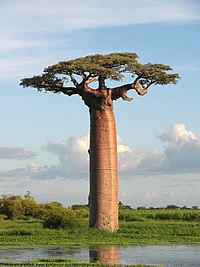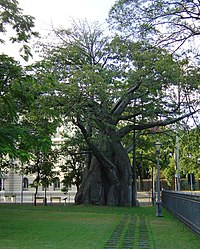Adansonia
| Adansonia | |
|---|---|

| |
| African Baobab tree near Kayes, Mali | |
| Scientific classification | |
| Kingdom: | |
| (unranked): | |
| (unranked): | |
| (unranked): | |
| Order: | |
| Family: | |
| Genus: | Adansonia |
| Species | |
|
See Species section | |
Adansonia is a genus of eight species of tree, six native to Madagascar, one native to mainland Africa and one to Australia. The mainland African species also occurs on Madagascar, but it is not a native of that island.
A typical common name is baobab. Other common names include boab, boaboa, bottle tree, upside-down tree, and monkey bread tree. The generic name honours Michel Adanson, the French naturalist and explorer who described A. digitata.
Description
Adansonias reach heights of 5 to 30 metres (16 to 98 ft) and have trunk diameters of 7 to 11 metres (23 to 36 ft). Glencoe Baobab - an African Baobab specimen in Limpopo Province, South Africa, often considered the largest example alive, up to recent times had a circumference of 47 metres (154 ft) and an average diameter of 15.9 metres (52 ft).[1] Recently the tree split up into two parts and it is possible that the stoutest tree now is Sunland Baobab, also in South Africa. Diameter of this tree is 10.64 m, approximate circumference - 33.4 metres.
Some baobabs are reputed to be many thousands of years old, which is difficult to verify as the wood does not produce annual growth rings, though radiocarbon dating may be able to provide age data.
Occurrence
The Malagasy species are important components of the Madagascar dry deciduous forests. Within that biome, A. madagascariensis and A. rubrostipa occur specifically in the Anjajavy Forest, sometimes growing out of the tsingy limestone itself.
A. digitata has been photographed growing in salt plains and by the sea, so may be a halophyte (salt tolerant).[2][3]
Species

- Adansonia digitata – African Baobab (western, northeastern, central & southern Africa, and in Oman and Yemen in the Arabian Peninsula, Asia)
- Adansonia grandidieri – Grandidier's Baobab (Madagascar)
- Adansonia gregorii (syn. A. gibbosa) – Boab or Australian Baobab (northwest Australia)
- Adansonia madagascariensis – Madagascar Baobab (Madagascar)
- Adansonia perrieri – Perrier's Baobab (North Madagascar)
- Adansonia rubrostipa (syn. A. fony) – Fony Baobab (Madagascar)
- Adansonia suarezensis – Suarez Baobab (Diego Suarez, Madagascar)
- Adansonia za – Za Baobab (Madagascar)
Water storage
Baobabs store water inside the swollen trunk (up to 120,000 litres (32,000 US gal)) to endure the harsh drought conditions particular to each region.[4] All occur in seasonally arid areas, and are deciduous, shedding their leaves during the dry season.
Uses

Since 2008, there has been increasing interest for developing baobab as a nutrient-rich raw material for consumer products.[5][6]
The leaves are commonly used as a leaf vegetable throughout the area of mainland African distribution, including Malawi, Zimbabwe, and the Sahel. They are eaten both fresh and as a dry powder. In Nigeria, the leaves are locally known as kuka, and are used to make kuka soup.[citation needed]
The fruit is nutritious possibly having more vitamin C than oranges and exceeding the calcium content of cow's milk.[7] Also known as "sour gourd" or "monkey's bread", the dry fruit pulp separated from seeds and fibers is eaten directly or mixed into porridge or milk. In Malawi, the fruit pulp is used to make a nutrient-rich juice.[7] In Zimbabwe the fruit is known as mawuyu in the shona language and has long been a traditional fruit. In the coastal areas of Kenya baobab seeds are called mabuyu and are cooked with sugar, colored, and sold as a snack.[citation needed] Mabuyu is also the term used in Tanzania for seeds of the calabash gourd, which are prepared in a similar fashion.
The fruit can be used to produce cream of tartar.[8] In various parts of East Africa, the dry fruit pulp is covered in sugary coating (usually with red coloring) and sold in packages as a sweet and sour candy called "ubuyu".
The seeds are mostly used as a thickener for soups, but may also be fermented into a seasoning, roasted for direct consumption, or pounded to extract vegetable oil. The tree also provides a source of fiber, dye, and fuel.
The dry pulp is either eaten fresh or used to add to gruels on cooling after cooking – a good way of preserving the vitamin contents. It can also be ground to make a refreshing drink with a pleasing wine-gum flavour. In Tanzania, it is added to aid fermentation of sugar cane for beer making.[9]
Pulp can be stored for fairly long periods for use in soft drink production but it needs airtight containers. Storage is improved by the use of sodium metabisulphite (Ibiyemi et al., 1988). It can also be frozen if ground to a powder .


Indigenous Australians used baobabs as a source of water and food, and used leaves medicinally. They also painted and carved the outside of the fruits and wore them as ornaments. A very large, hollow baobab south of Derby, Western Australia was used in the 1890s as a prison for Aboriginal convicts on their way to Derby for sentencing. The Boab Prison Tree still stands and is now a tourist attraction.
The whole fruit of the baobab is not available in the EU as current EU legislations from 1997 dictate that foods not commonly consumed in the EU have to be formally approved before going on sale. On 15 July 2008, the EU authorised the use of Baobab Dried Fruit Pulp as a food ingredient in smoothies and cereal bars Food Standards Agency website. More recently, Baobab Dried Fruit Pulp achieved GRAS status for these same food uses.[10]
A nonprofit organization, PhytoTrade Africa, plans to market the fruit for the benefit of around 2.5 million of the poorest families in southern Africa.[11][12]
The Baobab Fruit Co. of Senegal[13] currently markets baobab in Europe, and in North America through their agent Conceptula LLC.[14]
Traditional uses of the whole fruit are unlikely outside of Africa as the fruit will be processed for export as a white powder with a cheese-like texture to be used as an ingredient in products.[7]
Culture and myths
- Tabaldi is the name of the Baobab tree in Sudan and its fruit is Gongalis. Baobab's trunk is used as a tank to store water. People in west Sudan use the hollow in the trunk to save water in the rain season. Gongalis is used to make juice or to cure stomach and other diseases.
- Baobab trees are also seen in the mountain region of Saudi Arabia, near Al Baha
- Rafiki, in The Lion King, makes his home in a baobab tree.
- Ernst Haeckel mentions "monkey bread-fruit trees (Adansonia)" in his The History of Creation (Chap. 29), and claims that their "individual life exceeds a period of five thousand years".
- The owners of Sunland Farm in Limpopo, South Africa have built a pub called "The Big Baobab Pub" inside the hollow trunk of the 22 metres (72 ft) high Sunland Baobab. The tree, which is 47 m (155 ft) in circumference, is reported to have been carbon dated at over 6,000 years old.[15][16]
- The Senegalese band Orchestra Baobab is named for the Baobab Club in Dakar, which in turn takes its name from the tree.
- Singer Regina Spektor has a song called "Baobabs."
- Baobabs are cited in The Little Prince as a tree that may "split" a small planet into pieces.
- The Savanaur Baobabs, three trees of 14–18 m girth, believed to be 5000 years old, can be found in Savanur, Karnataka, India.
Gallery
-
Adansonia digitata, Tarangire National Park in Tanzania
-
Adansonia grandidieri, Avenue of the Baobabs, Madagascar
-
Baobab in Kruger National Park, South Africa
-
Boab Adansonia gregorii in Australia
-
Baobab flowers in Mulund, Mumbai, India
References
Notes
- ^ "Big Baobab Facts". Retrieved 2008-01-08.
- ^ http://www.arkive.org/baobab/adansonia-digitata/image-G50349.html – Baobab growing in a salt plain (access date 2010-07-19)
- ^ http://www.mail-archive.com/indiantreepix@googlegroups.com/msg08234.html – Baobabs growing close to the sea (access date 2010-07-19)
- ^ "The Baobab tree in Senegal". Retrieved 2008-10-01.
- ^ "Scientists predict African fruit trees could help solve major public health problem". Bioversity International. Retrieved 2008-10-01.
- ^ Hills S. "Baobab goes for GRAS ahead of 2010 World Cup" FoodNavigator.com-USA, September 30, 2008
- ^ a b c "New exotic fruit to hit UK shops". BBC. 2008-07-15. Retrieved 2008-07-15.
- ^ "Baobab tree -- a miracle of nature". Geo-Images Project. October 2000. Retrieved 2010-02-12.
- ^ [1]
- ^ FDA website
- ^ ukpress.google.com, Exotic fruit cleared for UK sale
- ^ news.bbc.co.uk, New exotic fruit to hit UK shops
- ^ Baobab Fruit Co. Senegal
- ^ Baobab-Fruit.com
- ^ Fancy a pint in the world's only bar that's INSIDE a tree?, Daily Mail, December 2007 Retrieved 20 December 2007
- ^ Of all the gin joints in all the world, Tristan McConnell in the Big Baobab Pub, Modjadjiskloof, South Africa, The Times, January 2007, Retrieved 20 December 2007
Further reading
- Baum, D. A.; Small, R. L.; Wendel, J. F. (1998). "Biogeography and floral evolution of baobabs (Adansonia, Bombacaceae) as inferred from multiple data sets". Systematic Biology. 47 (2): 181–207. doi:10.1080/106351598260879. PMID 12064226.
- Braun, K. (1900) Beiträge zur Anatomie der Adansonia digitata L. F. Reinhardt, Universitäts-Buchdruckerei, Basel, OCLC 15926986
- Colin, Tudge (2006, 2005). The Tree: A Natural History of What Trees Are, How They Live, and Why They Matter (1st U.S. ed.). New York, NY: Crown Publishers. ISBN 1400050367. OCLC 64336118.
{{cite book}}: Check date values in:|year=(help)CS1 maint: year (link) - Lowe, Pat. The Boab Tree. Port Melbourne, Australia: Lothian. ISBN 0850919126. OCLC 39079651.
- Pakenham, Thomas (2004). The Remarkable Baobab (1st American ed.). New York, NY: Norton. ISBN 0393059898. OCLC 56844554.
- Watson, Rupert (2007). The African Baobab. Cape Town, South Africa; London, England: Struik; New Holland. ISBN 9781770074309. OCLC 163617611.
- Wickens, G. E. (2008). The Baobabs: Pachycauls of Africa, Madagascar and Australia. Berlin, Germany; New York, NY: Springer Verlag. ISBN 9781402064302. OCLC 166358049.
{{cite book}}: Unknown parameter|coauthors=ignored (|author=suggested) (help)





